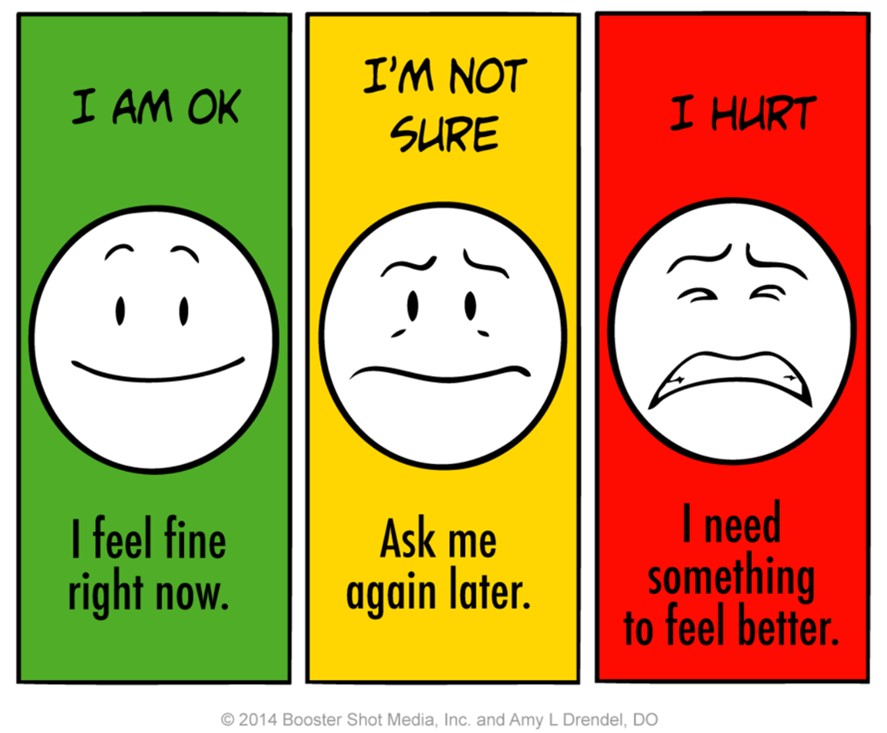Pain in Children
Learning about assessing pain in children
Pain can happen for so many different reasons and is not simple. It can change over time. The best treatment for your child’s pain will depend on many things, including if their pain is acute or chronic.
Acute pain can happen because of an injury or when a child is having a medical procedure, such as getting a needle. Acute pain usually lasts for a few hours or days.
Chronic pain lasts for more than 3 months and can be caused by specific conditions like arthritis or Crohn’s disease. But sometimes, the exact medical reason for chronic pain can’t be found.
No matter what kind of pain your child has, it’s important to understand and measure their pain and how it affects their life. This helps make sure that they can get the best pain treatment.
Your child’s healthcare provider will ask about where the pain is, how strong it is, and how long they’ve had it, and how it affects their life. A pain scale is often used to measure the level of your child’s pain. Your child’s healthcare provider may also ask questions about your child’s activities, sleep, and mood, especially for chronic pain. Once your child’s healthcare provider understands your child’s experience, they can recommend the right treatments for your child.
Treating your child’s acute pain may include:
- numbing creams put on the skin before painful medical procedures (like getting a needle)
- pain medicines
- distraction with books, music, or games
- heat or ice packs
- massage or physiotherapy
Treating your child’s chronic pain may include:
- distraction with books, music, or games
- heat or ice packs
- massage or physiotherapy
- psychological therapy (ways to cope that are developed with a psychologist)
- pain medicines are sometimes needed
The goal of managing your child’s acute pain should be to lessen their pain, even if it can’t go away completely. If your child has chronic pain, it’s not always possible to make the pain completely go away. When helping your child with chronic pain, the goal is improving how much your child can do. This means making sure that they feel good going to school, playing sports, seeing their friends, and sleeping well.
How will my child’s pain be measured?
It’s always best if your child can tell their healthcare provider directly how much pain they have. Sometimes your child can’t do this. For example, if they’re too young to talk or have a disability that keeps them from expressing themself. If this is the case, your child’s healthcare provider will likely ask you to tell them about your child’s pain, since you know your child best.
For acute pain, your child’s healthcare provider may use a pain scale to help measure your child’s pain. The scale they choose will be based on your child’s age and ability to talk about their pain.
For children under 4 years old or who are non-verbal, the FLACC scale may be used. If this scale is used, your child’s healthcare provider will be measuring your child’s pain by looking at:
- facial expressions
- the position of their legs
- how active they are
- if they’re crying,
- if they can be calmed down
For children between 4 and 12 years old, the Faces Pain Scale may be used. This scale has 6 faces that show how much something can hurt. Your child will choose the face that shows how much pain they have.
For children older than 6 years of age, the Verbal Numerical Rating Scale may be used. If this scale is used, your child will be asked to choose a number from 0 to 10 that best describes their pain. In this scale, 0 is no pain and 10 is the worst pain they can imagine.
There are many other types of pain scales that may be used depending on your child’s age, ability to communicate, and level of development.
If your child has chronic pain, their healthcare provider will be thinking about both the rating of the pain and how your child’s pain affects their life. Things that your child’s healthcare provider might ask your child about include:
- school attendance
- what activities they can do
- how they’re sleeping
- how they’re coping with their pain emotionally
You can learn more about chronic pain in children from the ECHO research program website. Evidence in Child Health to Enhance Outcomes (ECHO) uses evidence and research to provide information to help improve the health of children in Alberta.
How can I measure my child’s pain at home?
It’s important that you continue to monitor your child’s pain on a regular basis once you’re home. You can track your child's pain at home using a pain diary to help your child's healthcare provider understand what is going on.
If your child had surgery, you can use a scale called the Parents’ Postoperative Pain Measure. With this scale, you answer yes or no to 15 questions about your child. If you answer yes to more than 6 questions, your child may be having serious pain and needs to have that pain taken care of.
Another newer pain scale that you can try using is called the Stoplight Pain Scale. You can use this scale to ask your child how they’re feeling and if they think they need pain medicine to help make their pain better.

If your child has chronic pain, ask your healthcare provider for information on how to measure your child’s pain at home.
If you have any other questions about how to measure or treat your child’s pain at home, ask your healthcare provider or learn more at Pain in Children.
To see this information online and learn more, visit MyHealth.Alberta.ca/health/pages/conditions.aspx?Hwid=custom.ab_pain_assessment_inst_child.

Related to Pain in Children
For 24/7 nurse advice and general health information call Health Link at 811.
Current as of: February 28, 2024
Author: Solutions for Kids in Pain (SKIP), Alberta Health Services
This material is not a substitute for the advice of a qualified health professional. This material is intended for general information only and is provided on an "as is", "where is" basis. Although reasonable efforts were made to confirm the accuracy of the information, Alberta Health Services does not make any representation or warranty, express, implied or statutory, as to the accuracy, reliability, completeness, applicability or fitness for a particular purpose of such information. Alberta Health Services expressly disclaims all liability for the use of these materials, and for any claims, actions, demands or suits arising from such use.
